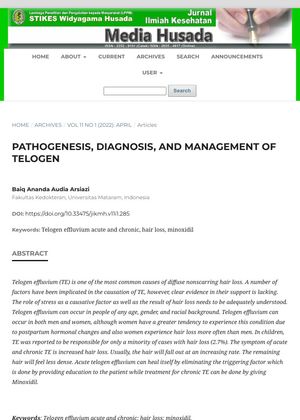Pathogenesis, Diagnosis, and Management of Telogen Effluvium
April 2022
in “
Jurnal Ilmiah Kesehatan Media Husada
”

TLDR Telogen effluvium is a common, reversible hair loss condition treatable with patient education and sometimes Minoxidil.
Telogen effluvium (TE) is a common cause of nonscarring hair loss that can affect individuals of any age, gender, and racial background. Stress is often implicated as a causative factor, but clear evidence is lacking. Women are more likely to experience TE due to postpartum hormonal changes, and only 2.7% of hair loss cases in children are due to TE. The main symptom of both acute and chronic TE is increased hair loss, with the remaining hair feeling less dense. Acute TE can often resolve itself by eliminating the triggering factor, which is achieved through patient education. Chronic TE, on the other hand, can be treated with Minoxidil.





